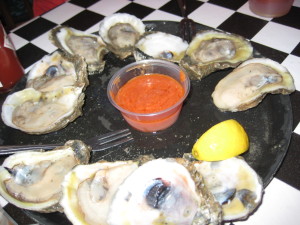We talked to former professor of food safety, Douglas Powell, about the safest ways to eat the things we love.
Baked Goods
 The Concern: While it’s been more than 10 years since the Food Allergen Labeling and Consumer Protection Act went into effect, unlabeled allergens—most often peanuts, tree nuts, wheat, soy, dairy, fish, shellfish and eggs—are still the number one cause of recalls for FDA-regulated foods. And they often crop up unannounced in bakery products.
The Concern: While it’s been more than 10 years since the Food Allergen Labeling and Consumer Protection Act went into effect, unlabeled allergens—most often peanuts, tree nuts, wheat, soy, dairy, fish, shellfish and eggs—are still the number one cause of recalls for FDA-regulated foods. And they often crop up unannounced in bakery products.
Small Thing to Keep in Mind: If you have an allergy, check the label each time you buy a product, because manufacturers sometimes change recipes and a trigger food may have been added. Here’s a helpful list of unexpected words to watch out for, broken down by the type of diet you’re following.
Cantaloupe
The Concern: These orange-fleshed melons are different from honeydew and watermelon, since their “netted” exterior is more porous, so contaminants from soil, water, animals (and their manure) can get trapped in the rind. Plus, unlike other fruits, they’re not acidic, so pathogens can grow more easily once you cut the melon open.
Small Thing to Keep in Mind: As many of us already do, avoid buying cantaloupes that look bruised; and, if you purchase precut cantaloupe, make sure it’s refrigerated or on ice. Finally, don’t let the sliced fruit sit out at room temperature for more than two hours.
Chicken
The Concern: This popular meat (we buy about 86 pounds per capita annually) is one of the most common causes of foodborne illness.
Small Thing to Keep in Mind: A good recommendation is to buy chicken last when you’re grocery shopping, since keeping it cold can prevent bacteria overgrowth. Also, be sure to defrost frozen chicken safely and cook it to 165 degrees (use a meat thermometer).
Sprouts
The Concern: Alfalfa, clover, radish and mung bean sprouts, which add crunch to salads and sandwiches, score well nutritionally. But in recent years, there have been at least 30 food-related illness outbreaks linked to raw and lightly cooked sprouts.
Small Thing to Keep in Mind: If you enjoy sprouts in salads, buy only ones with fresh, clean, white stems and roots that have been kept properly refrigerated. Dr. Powell says the safest way to prepare sprouts is to cook them thoroughly before eating (so, stir-fries and pad Thai are fine).











